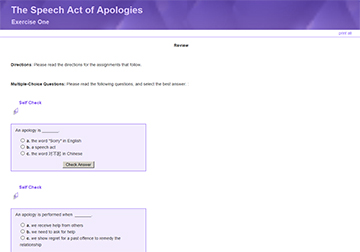Unit 1 Introduction
Unit 1 presents a brief introduction to the speech act of apology and helps students understand the importance of learning how to appropriately make apologies in everyday communication. This unit also provides students with corresponding exercises to practice.
1.1 Goal of Unit 1
The goal of Unit 1 is to engage students’ attention to the speech act of apology and to introduce the definition and characteristics of apology to students. After studying this unit, students are expected to have a clearer idea of when and why to apologize in everyday communication.
1.2 What is an Apology?
Let’s first look at a scenario adapted from Blum-Kulka et al. (1989).
You have borrowed a book from one of your classmates in the Chinese class, which you promised to return today. When meeting your classmate and being asked about the book, however, you realize that you forgot to bring it along.
After reading this scenario, how would you respond to your classmate? No matter what is on your mind now, “sorry” in American English or “对不起duìbùqǐ” in Chinese, you definitely need an expression to show your regret and to remedy your fault. In other words, an apology should be performed here.
Like expressions of gratitude and request making, an apology is also a speech act. According to Holmes (1990), an apology is a speech act performed by the speaker to remedy a past offence or mistake that he/she is responsible for, and therefore to restore the relationship between the speaker and the hearer.
Thinking: How many apologetic expressions in American English and Chinese can you think of?
1.3 About the Speech Act of Apology
According to previous studies on apology, we can summarize some characteristics of the speech act of apology below:
- An apology is based on a past act, which the speaker thinks has offended the hearer and he/she should take responsibility for. This is similar to the speech act of thanking, which is also performed on a past act.
- Successful realization of an apology is potentially beneficial to the hearer but may be at cost to the speaker to some degree. Because the performance of an apology means the speaker admits to the fault and takes on responsibility for the past act he/she did.
- An apology is performed to achieve the goal of restoring the relationship between the speaker and the hearer. According to Leech (1983), performance of apology has the social function of maintaining harmony between the speaker and the hearer, and therefore appropriate expression of apology is an important part of appropriate communication in everyday life.
Thinking: Thinking back on expressions of gratitude we have learned, how is it different from apologies?
Review
To review the ideas in this section, please click on the Review link.
